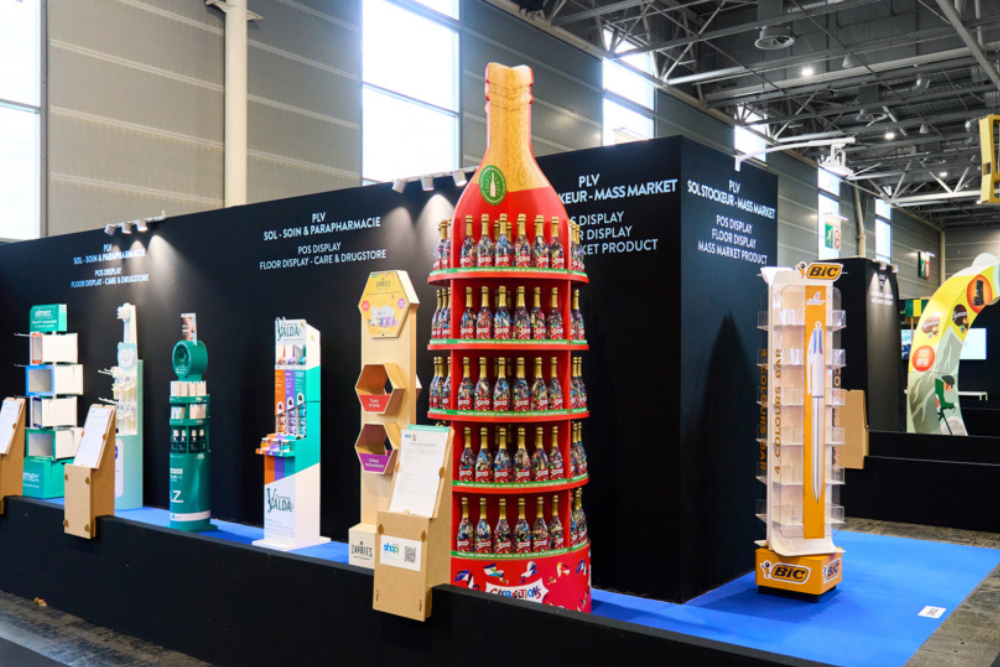In this article:
• Industrial designers transform briefs into feasible, functional, and visually attractive POS displays.
• At POP Solutions, industrial design is carried out in co-creation between account managers, studio, and production teams.
• When fully integrated into the process, eco-design reduces the environmental impact of displays while maintaining their commercial impact and effectiveness in the field..
Behind the scenes at POP Solutions… Every display starts with a vision. Between the client’s brief and the display installed in-store, industrial designers play a crucial role, turning ideas into tailored solutions that are visually attractive, functional, and feasible. For them, each display project is a careful balancing act of creativity, engineering and pragmatism.
To better understand this often-overlooked role, let’s explore the career and daily work of Lucien Tirou, industrial designer at POP Solutions. This video portrait shows how he brings our clients’ visions to life.
Lucien’s profile
An industrial designer’s job is to transform a client brief into a specific solution. Each project must result in a display that’s visually appealing, functional, practical, and ready for production. It’s all about balance: translating a brand’s vision into something achievable, stable, eye-catching, and effective at the point of sale.
As Lucien puts it: “As an industrial designer, I take our clients’ ideas and bring them to life by creating attractive, practical, and responsible POS displays that grab attention in stores—while making sure they’re technically and logistically feasible.”
At POP Solutions, industrial designers are pivotal to our production process. Working from briefs provided by account managers, they develop solutions that accurately reflect client expectations.
The account manager is the main brand contact, while the designer closely collaborates with model makers, graphic designers, and manufacturing teams to bring projects to life. This collaborative approach ensures seamless continuity from initial concept to final display and keeps co-creation at the center of everything we do—from concept all the way through to the display’s entire lifecycle: design, materials, production, logistics, use, end of life (recycling).
At POP Solutions, eco-design is one of the key approaches our industrial designers use to create more responsible point-of-sale displays.
For Lucien, it’s all about bringing customer ideas to life—sometimes by making more responsible choices: selecting certified or recycled materials, streamlining assembly, extending display lifespan, or creating modular designs.
Take the Celebrations display we designed for Mars and Total Marketing Support (TMS), for example. Made from FSC cardboard and assembled with interlocking tabs (no glue needed!), it improved its environmental score by around 50% according to Sustain®.
The Sustain® tool, developed by POPAI and based on life cycle analysis (LCA), measures factors like carbon footprint, water consumption, and resource usage.

Did you know?
With the Green Deal, the European Union is now implementing new eco-design requirements to improve product circularity, repairability, and reusability.
Belgium closely follows these guidelines, as shown by certifications like the EcoVadis Gold medal, which POP Solutions has now maintained for three years straight.
We also use the ASKOR tool—a life cycle analysis tool that works across any industry and complies with ISO 14040-44 standards. For POP Solutions, it measures a display’s environmental impact throughout its entire lifecycle—carbon footprint, water consumption, resource usage—and identifies specific improvement opportunities. This approach helps us build an eco-design practice based on reliable data, aligned with European requirements and our customers’ CSR commitments.
Industrial design goes beyond aesthetics. It delivers genuine operational value to brands. A well-designed display captures attention in stores, reinforces brand identity, and stands out from competitors. It also optimizes costs, simplifies assembly, and accounts for logistical constraints (especially those of carriers and distributors). And when eco-design is integrated from the concept phase, it helps reduce the campaign’s environmental impact without compromising on creativity or in-store effectiveness.
At POP, industrial design combines creativity with realism to transform every idea into a hands-on, impactful solution.
Lucien is the perfect representation of this highly expert profession, but he never works alone: at POP, an integrated team of sales reps, designers and workshop teams brings projects to completion. Together, they shape a brand’s ambitions according to the highest standards—and always with purpose.
Have an idea for POS advertising? Let’s bring it to life together. Get in touch with POP Solutions today.